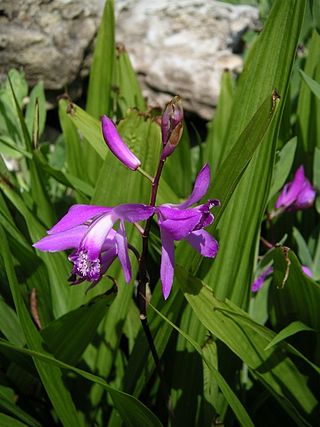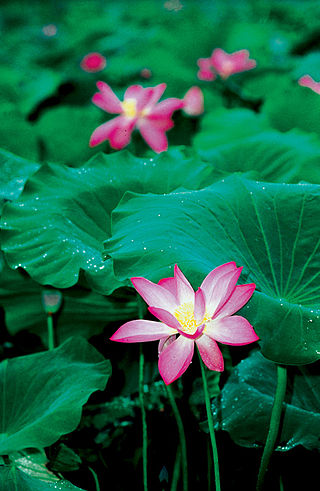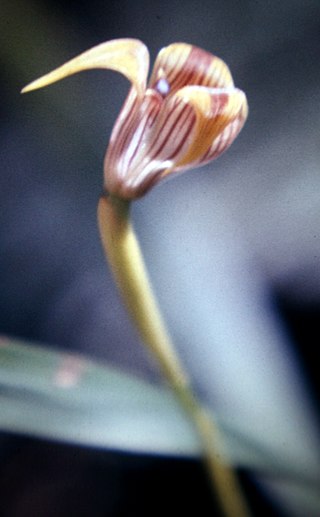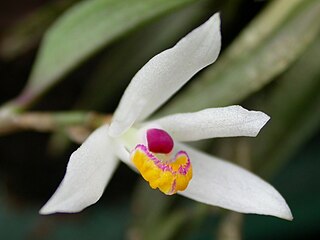
Orchids are plants that belong to the family Orchidaceae, a diverse and widespread group of flowering plants with blooms that are often colourful and fragrant.

Ancistrochilus is a genus of the orchid family (Orchidaceae), comprising only 2 species.

Ansellia is considered a monotypic genus of orchid, with only one species, Ansellia africana, commonly known as African ansellia or leopard orchid, however, it may in fact be a complex group of species which share common floral structure and growth habit.

Bletilla, common name urn orchid, is a temperate, terrestrial genus of orchids containing five currently recognized species distributed through China, Japan, Taiwan, south to Vietnam, Thailand and Myanmar. The name is actually a diminutive of Bletia because of the resemblance between the two genera even though Bletia is a New World genus. The genera JimensiaRaf. and PolytomaLour. ex Gomes are generally included into Bletilla. This genus is abbreviated Ble in trade journals.

Laelia speciosa, commonly known as the Mayflower orchid, is a species of showy orchid found in area of Mexico with high elevation of 1,400 m (4,593 ft) to 2,400 m (7,874 ft). The plant is very drought resistant and can tolerate cool to warm conditions. It blooms from summer to fall, producing fragrant flowers. There are usually three to four flowers on an inflorescence.

This is a list of plants commonly found in Kakadu National Park, Northern Territory of Australia. Where known, common names are given in English and in Gun-djeihmi, a commonly spoken indigenous language in the area, are given in parentheses.

Dendrobium kingianum, commonly known as the pink rock orchid, is a flowering plant in the orchid family Orchidaceae and is endemic to eastern Australia. It usually grows on rocks, rarely as an epiphyte, and has thin, spreading leaves and spikes of up to fifteen, usually pink flowers in late winter to spring. It is popular in Australian native horticulture and is a commonly cultivated orchid among Australian orchid species growers.

Dendrobium speciosum, commonly known as the rock orchid or cane orchid, is a species of highly variable Australian orchid. Its varieties can be found in a range of habitats as epiphytes or lithophytes. It has a continuous distribution along the east coast of Australia and in distinct populations along the Tropic of Capricorn. As a lithophyte, it forms gigantic spreading colonies on rocks and cliff faces, often exposed to full sun, with its roots forming dense, matted beds across the rock that anchor the plant. It can be found at altitudes from sea level to 900 metres (3,000 ft).

Trigonidium, abbreviated as Trgdm in horticultural trade, is a genus of orchids comprising roughly twenty species found from Mexico to Brazil.

Cattleya aclandiae, or Lady Ackland's cattleya, is a species of orchid from the genus Cattleya, named in honor of Lady Lydia Elizabeth Ackland, wife of Sir Thomas Dyke Acland, 10th Baronet who was the first European to grow the plant successfully. The illustration of the plant which accompanied its first description was based on a drawing by Lady Ackland. The genus was named in honour of William Cattley, a prominent British merchant and horticulturist.

Odontoglossum crispum, the curled odontoglossum, is an epiphytic orchid from the genus Odontoglossum. It is considered by many to be the most beautiful orchid of all but is also one of the most difficult to grow.

Acriopsis emarginata, commonly known as the pale chandelier orchid, is a species of orchid endemic to Queensland. It is a clump-forming epiphyte with dark green leaves and curved, branching flower stems with many white and cream-coloured flowers.

Coelogyne fimbriata is a species of orchid.

Coelogyne flaccida is a species of orchid that is native to southeast Asia and northeastern South Asia. Cultivated as an ornamental plant, it is also known as the bearded Coelogyne and the loose Coelogyne.

Maxillaria tenuifolia, the delicate-leafed maxillaria or coconut pie orchid, is a species of orchid ranging from Mexico to Nicaragua and possibly Costa Rica. These plants are easy to grow if kept moist and given good air movement in a high-light windowsill of any orientation but North.

Phalaenopsis bellina is an orchid endemic to Borneo. It is one of 75 species of Phalaenopsis and one of the most commonly cultivated species in the genus.

Loefgrenianthus blanche-amesiae is a showy orchid species, inhabitant of Serra do Mar mountains in Brazilian southeast. It is the only species of the monotypic genus Loefgrenianthus. It can be differentiated from its closest genus, Leptotes, both because of its pending vegetation with flat leaves and the flowers which have a saccate labellum. Loefgrenianthus blanche-amesiae is highly appreciated by orchid collectors.

Cattleya rex is a species of epiphytic orchid of showy white flowers, native to montane forests in Peru and Bolivia.

Psychopsiella is a monotypic genus in the orchid family found only in the state of Rio de Janeiro in Brazil and near Caracas in Venezuela. It grows as an epiphyte in evergreen montane forests at elevations of 800 to 1,500 metres.

Broughtonia sanguinea, also known as blood red broughtonia is a plant in the genus Broughtonia, a member of the family Orchidaceae. It was named in 1813 by its first describer, Robert Brown, for 18th century English botanist Arthur Broughton.




















